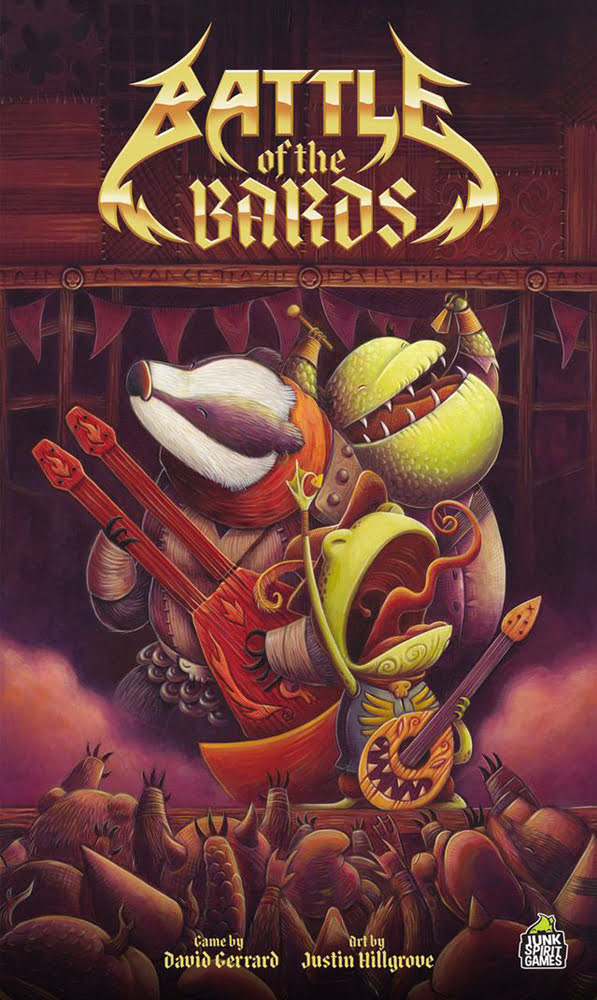
It’s time for the Battle of the Bards! Performers from all over Tessandor have gathered to sing their odes to glorious adventures—but which troupe will capture the most audiences?
What Is Battle of the Bards?
Battle of the Bards is a deck-building, dice-management game for 2 to 4 players, ages 10 and up, and takes about 30–60 minutes to play. It’s currently seeking funding on Kickstarter, with a pledge level of $29 for a copy of the game (check the shipping if you’re outside of the United States); there’s also a $10 pledge level for the print-and-play if you want to make it yourself. I think the age rating is about right; the artwork and theme are all kid-friendly, so it’s just a matter of the rules complexity.
(Update 1/28/19) Junk Spirit Games decided to cancel and relaunch with a lower price point on the base game, so I’ve updated the pricing here to reflect that.
New to Kickstarter? Check out our crowdfunding primer, and visit our Kickstarter curated page for more projects we love.
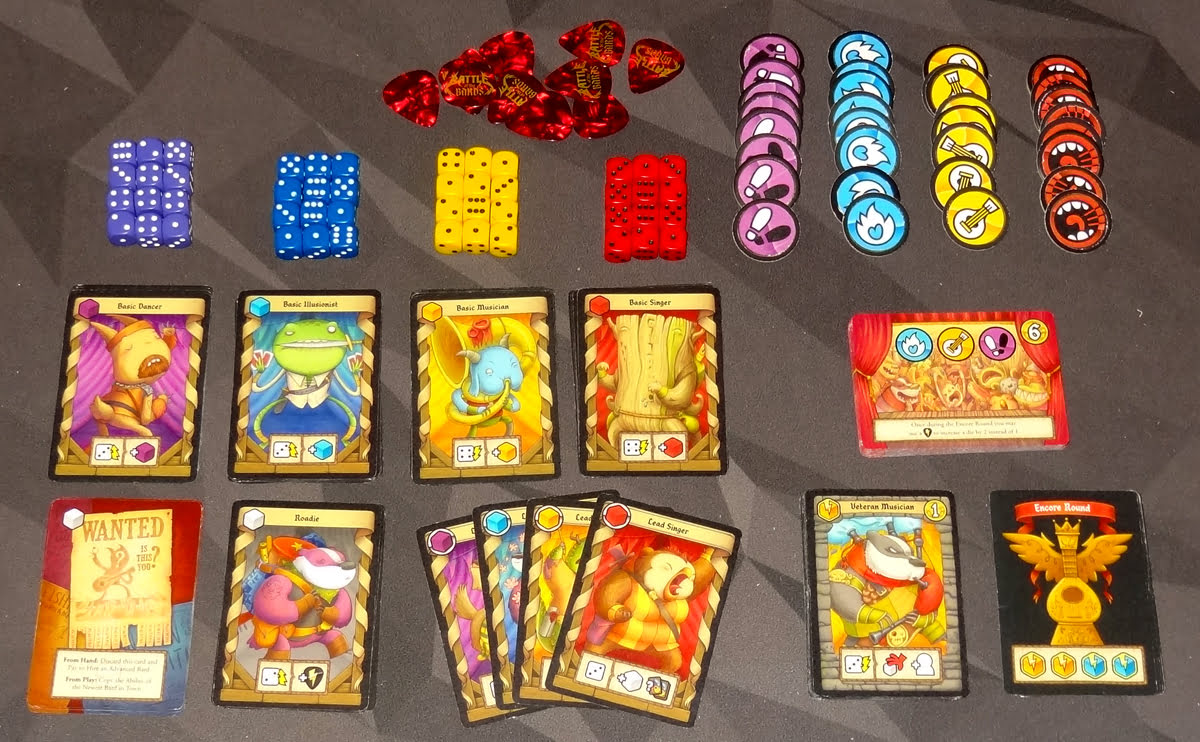
Battle of the Bards Components
Note: My review is based on a prototype copy, so it is subject to change and may not reflect final component quality.
- 32 Basic Bard cards
- 4 Lead Bard cards
- 4 Roadie cards
- 8 Wanted Poster cards
- 20 Veteran Bard cards
- 26 Audience cards
- 6 Encore Round cards
- 32 Performance tokens (8 each in 4 types)
- 16 Tune tokens
- 60 Dice (15 each in 4 colors)
- First Player marker
The artwork in Battle of the Bards, as in the other games from Junk Spirit Games, is by Justin Hillgrove, and is also set in the world of Tessandor (see also: By Order of the Queen). I really love his art style, and the characters—which include anthropomorphic animals and trees, as well as more humanoid beings—are delightful. And in this game, they all happen to be rocking out. The bard types include Dancers, Illusionists, Musicians, and Singers, which will play into what types of dice they’ll give you when you play the cards.

The performance tokens are colored to match the corresponding bards and dice, and they also have a little icon that represents the type of performance, like a mandolin for the musician and footprints for the dancer. Those help make the game color blind friendly, as long as you can differentiate between the dice themselves, which have no distinctions except color.
The components themselves are fine—mostly cards, dice, and cardboard tokens, which are all pretty standard. The one component that stands out is the tune tokens: you can add $10 to your pledge to change the cardboard tune tokens to actual guitar picks (and add a card expansion pack). The final picks will be black instead of red, you see in the prototype photos. It’s a neat touch for a music-based game, even if it’s not totally necessary.
How to Play Battle of the Bards
You can download a draft of the rulebook here.
A quick note: Battle of the Bards is a deck-building game, which means that each player has their own draw deck and discard pile. You will gain cards over the course of the game (usually adding them to your discard pile), and you typically draw cards from your own deck. If you run out of cards, you shuffle your discard pile to form a new deck.
The Goal
The goal of the game is to score the most points by hiring bards and giving performances that captivate audiences.

Setup
Shuffle the audience cards, and flip over the top three audience cards next to the deck to form an audience row. Also, turn the top card of the deck face-up on top of the deck.
Shuffle the Veteran Bard cards, and flip over four cards in a row next to the deck—this is the Veteran Bard Line. The card closest to the deck is the “Newest Bard in Town.”
Shuffle the Encore cards and deal one to each player. These are kept secret, and show four dice icons—you’ll want to hire bards matching these four icons over the course of the game if you can.
Give each player a starting deck:
- 2 Basic Dancers
- 2 Basic Illusionists
- 2 Basic Musicians
- 2 Basic Singers
- 2 Wanted Posters
- 1 Roadie
- 1 Lead Bard (randomly chosen)
Everyone’s starting deck will be identical with the exception of the Lead Bard—everyone will have a different type of bard, giving them a slight nudge in that direction. You start with one performance token and two dice matching your Lead Bard.
Shuffle your starting deck together, and draw 4 cards.
The player who most recently performed on stage gets the first player marker.
Gameplay
Each round will have some portions that are done simultaneously by all players, and portions that are turn-based:
- Take the Stage (simultaneous)
- Put on a Show (turn-based)
- End of Round (simultaneous
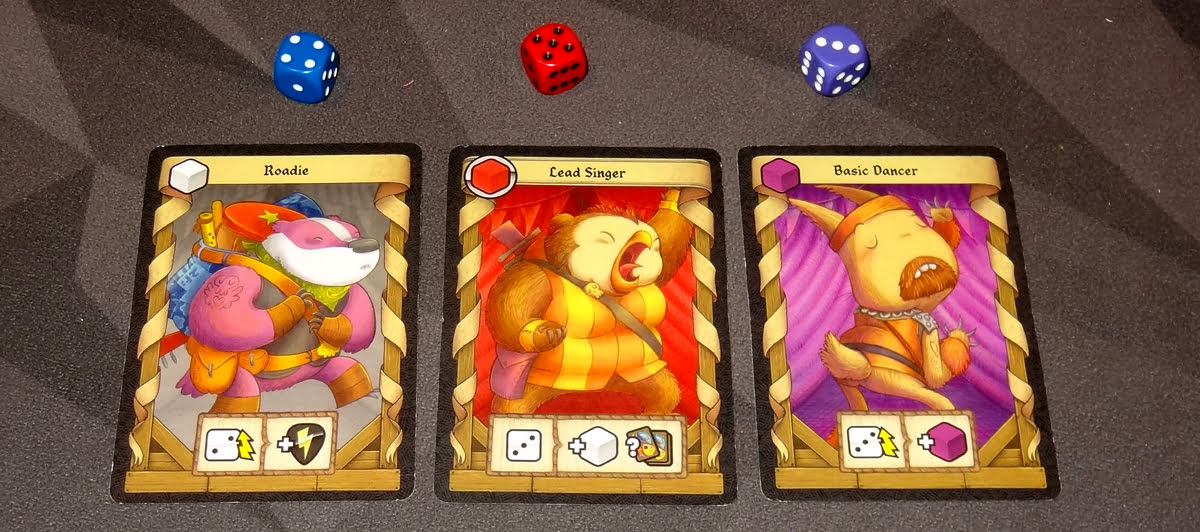
Take the Stage
Everyone chooses three of the cards in their hand to put on stage, keeping the fourth in hand. Everyone reveals their on-stage cards simultaneously, placing them in front of themselves. In turn order, take dice from the supply matching the icons at the top of your three cards and add them to your dice pool. (White icons are wild and you may take any color. If there are not enough matching dice, you just take what is available.) Then everyone rolls their own dice.
Put on a Show
In turn order, everyone will take two actions until everyone has passed; this is the bulk of the game. There are several actions available, explained below.

Create a Performance: Discard 3 of your dice back to the supply in a sequence (like 3-4-5) to gain a performance token. If the majority of your dice are a matching color, you take the token of that color; otherwise, take a token that matches any of the dice you discarded.

Use a Bard Ability: Place one of your dice onto one of your on-stage bards to use its effect. Each bard has a space showing what dice value it requires (e.g., “2 or lower,” “3 or higher,” “exactly 5”). You do not have to use a die that matches the bard’s color, and each bard may only be used once per round. There are various effects, including gaining more dice from the pool, gaining performance tokens, playing additional cards onto your stage, and so on. “Sustain” effects give you either another action for your turn, or you can rotate the bard card to activate an ongoing effect for the rest of the round.
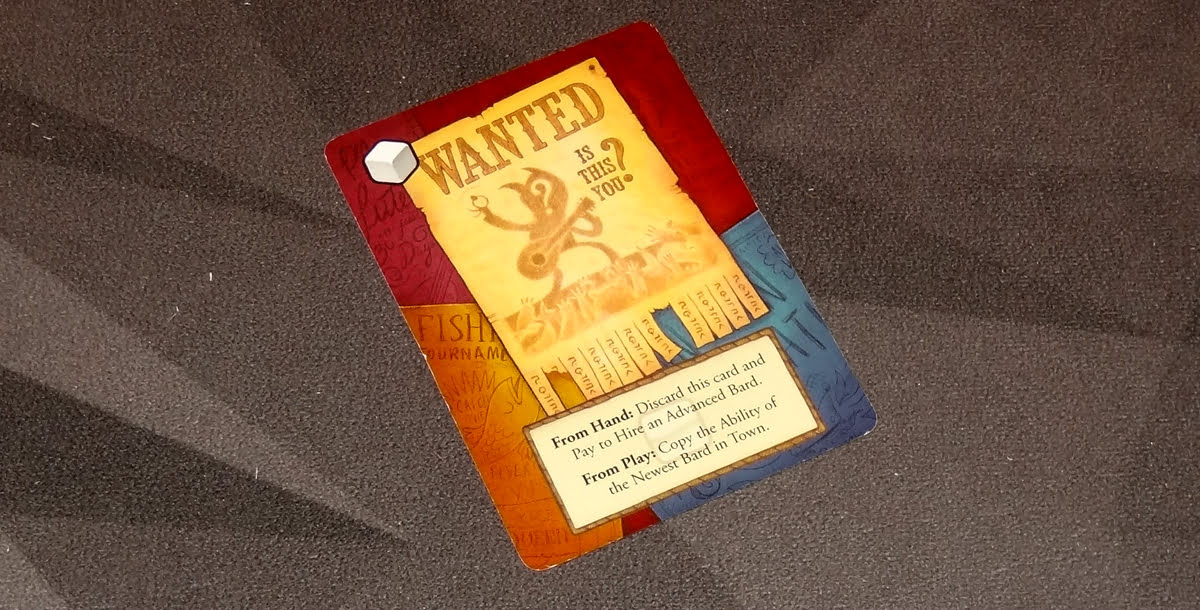
Hire a Veteran Bard: To hire a new bard from the bard line, you must have a Wanted Poster in your hand. Discard your Wanted poster, and then discard 2 dice with the same value (any colors) to hire a bard. To hire the Newest Bard in Town, you must discard 3 dice of the same value instead. Discarded dice are returned to the supply, not to your own dice pool. Slide the bards away from the deck to fill in empty spaces, and then refill the bard line.
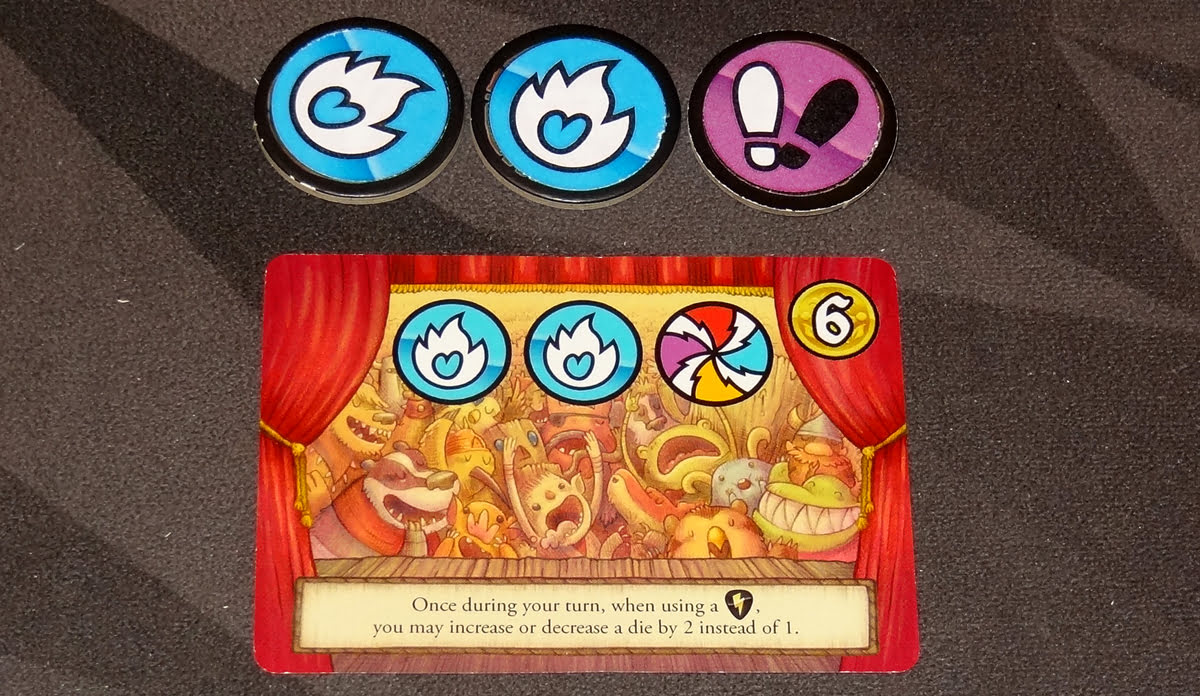
Capture an Audience: Discard the required performance tokens to take one of the audience cards from the row. Audience cards also give you an ongoing permanent ability. Note: To take the face-up card on top of the audience deck, you must spend the required performance tokens and discard the card from your hand. Refill the audience row as needed and turn the top card of the audience deck face-up.
You may also use “tune” as a free action by discarding a tune token or the card from your hand: tuning allows you to increase or decrease a die by 1 pip, or re-roll any number of your unused dice. (You may not wrap from 1 to 6 or vice versa.)
End of Round
Once everyone has passed, everyone discards all the bards they played this round. If you still have a card left in your hand, you may either discard it or fire it, removing it from the game. Then draw back up to 4 cards (shuffle your discard pile if necessary), and keep any dice that were not discarded in your pool. Pass the first player token clockwise and start a new round.
Game End
When a player has captured four audience cards, the game will end after that round is finished (when all players have passed). There is one more step: the Encore Round!
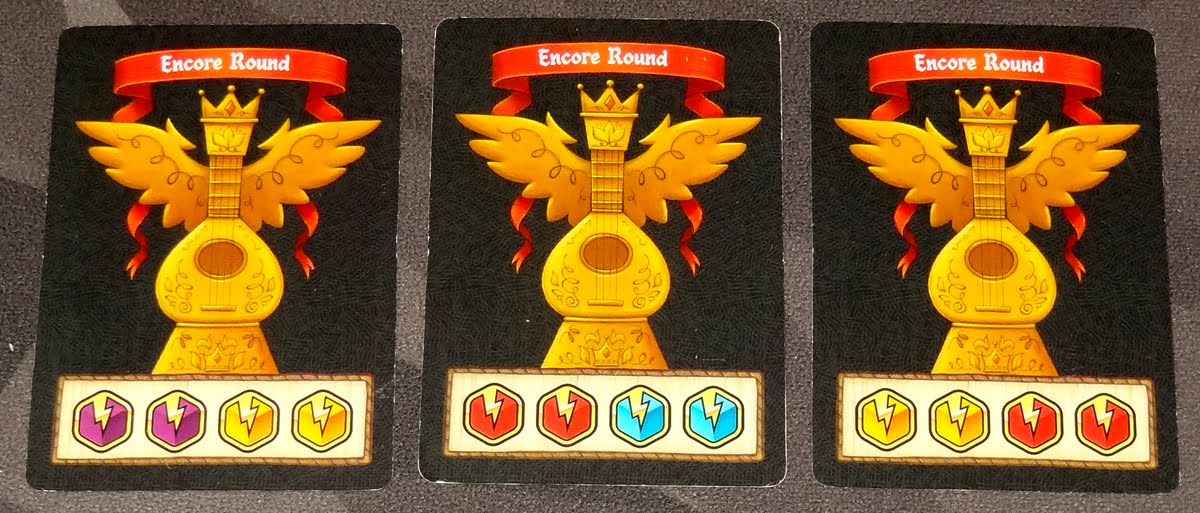
Everyone reveals their Encore card, and compares it to the veteran bards they have hired during the game (in your deck, hand, and discard pile). For each icon that you have matched to a bard, you get one die (up to 4 dice maximum). Then everyone rolls their encore dice—the highest total wins the Encore Round and scores 4 points. (You may use tune tokens during the Encore Round.) If there is a tie, the tied players re-roll until there is a winner.
Add up your score:
- Performance tokens are worth 1 point each.
- Audience cards are worth their face value.
- Veteran Bards are worth their face value.
- The Encore Round winner gets 4 points.
Whoever has the highest score wins! In a tie, there is a Sudden Death tie breaker—randomly select one of the unused Encore Round cards, and the tied players gain dice according to that card, plus one additional die. Highest roll wins; re-roll ties. (No tune tokens may be used in the Sudden Death round.)

Why You Should Play Battle of the Bards
Battle of the Bards is a fun blend of deck-building and dice management: each piece feeds into the other one. Bards generate dice when they get on stage, which then turn into performance tokens, which then capture audiences. But you’ll also need those dice to recruit even better bards to your troupe, who are even better at performing (giving you more dice or even performance tokens).
I always like to see deck-building used in different ways, and Battle of the Bards differs in a few ways from other games in this genre. For instance, to gain a new card (hiring a Veteran Bard), you must have the Wanted Poster in your hand—and since you only have 2 of those in your deck, that means that you’ll only be able to hire bards at a certain pace. The bigger your deck, less frequently you’ll draw those Wanted Posters. And if you draw both of your Wanted posters in the same hand? Well, one of them will be played on stage (and becomes a copy of the Newest Bard in Town for that round), so you can only hire one new bard this round. And that’s assuming you have a pair of matching dice, too.
Another difference is the built-in weeding mechanism. In most deck-building games, weeding weaker cards out of your deck can be a very useful strategy, but you’re dependent on special card effects to do so. Here, you can always fire the fourth card in your hand. The downside is that there are also a few different uses for the leftover card in your hand: hiring a new bard (if it’s a Wanted Poster) or discarding it to tune or capture the top card of the audience deck. However, the more quickly you can fire your basic bards, the more often you’ll be able to play your more powerful veteran bards.
It’s also interesting that you’ll have to decide each round which three of your four cards you want to play. In some sense, that’s reminiscent of the original deck-building game Dominion, in which you only had 1 action per turn (and had to use card effects to gain additional actions). But many deck-building games now just let you play your entire hand. Having to choose which three to use, particularly when you don’t know what other players may be doing, adds a little bit of guesswork to the game.
Because it’s a dice game, there’s a fair amount of luck involved, of course: you need pairs (or triples) to hire new bards, sequences to get performance tokens, and specific values to use your bard abilities. Thankfully, there are ways to manipulate the dice, either adjusting their values, rerolling them, or even swapping dice with other players. If you feel like you have bad luck with dice rolls, then you should invest in veteran bards with tune token abilities, or else just try to get a lot of extra dice so you have a higher chance of rolling the numbers you need.
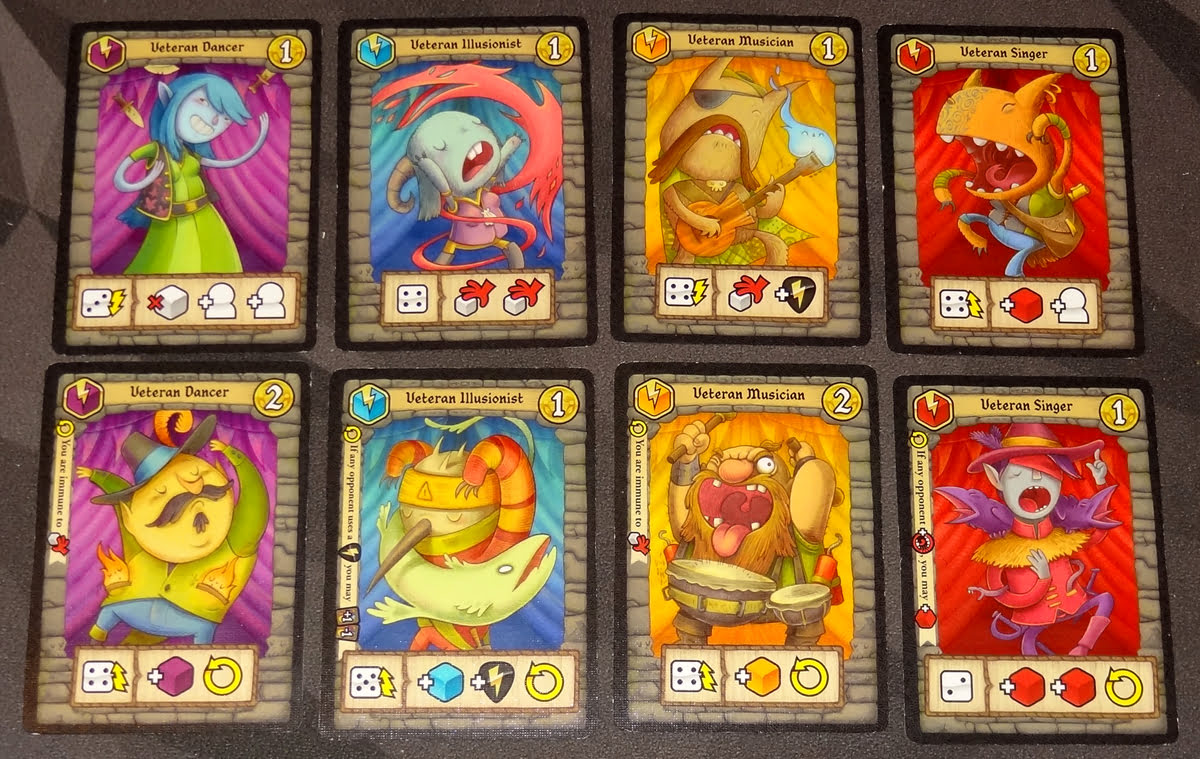
Part of the strategy is figuring out which bards to hire. You’ll probably want to try getting the bards that match your Encore Round card so you don’t miss out, but keep in mind that it’s only worth 4 points. Sometimes it may be worth hiring a veteran bard that doesn’t help in the Encore Round simply because you like its ability, or to prevent another player from doing so. You might also hire bards so that you can get certain dice colors into your dice pool, based on what performance tokens you’ll need to capture an audience. The trick there, of course, is that the audience row changes over the course of the game as players take them: if you build up a bunch of dancers but then the dance-focused audiences are captured, you might need a way to shift gears and start singing instead. I also like the ability to use a Wanted Poster as a copy of the Newest Bard in Town, in case you really want that ability but can’t hire them permanently or don’t want to wait until they cycle back through your deck.
The Encore Round is a thematic way to end the game, though I don’t know that it adds a whole lot to the gameplay for me. Four points is the same as some of the lower-valued audience cards, but it’s not enough to drive your entire strategy, either. And while most of the game is about trying to make dice combinations, the Encore Round is purely a roll-off. I’ve had games where the player with 4 dice lost to somebody with only 2 dice, simply because of bad rolls. Again, you can control your luck somewhat if you’ve collected tune tokens, but it can be dissatisfying if you lose only because of a dice roll. So far the game hasn’t usually come down to just the Encore Round, but it can be enough to determine the winner in a close game.

Overall, I’ve enjoyed Battle of the Bards. I like the mixture of card play and dice rolling, trying to figure out what combination of bards will pay off with the best performances. There are features that set it apart from other deck-building games, and the quirky artwork by Justin Hillgrove is applause-worthy in itself. If you enjoy deck-building and lots of dice-rolling, get yourself a troupe and join the competition!
For more information or to make a pledge, visit the Battle of the Bards Kickstarter page.
Click here to see all our tabletop game reviews.
![]() To subscribe to GeekDad’s tabletop gaming coverage, please copy this link and add it to your RSS reader.
To subscribe to GeekDad’s tabletop gaming coverage, please copy this link and add it to your RSS reader.
Disclosure: GeekDad received a copy of this game for review purposes.



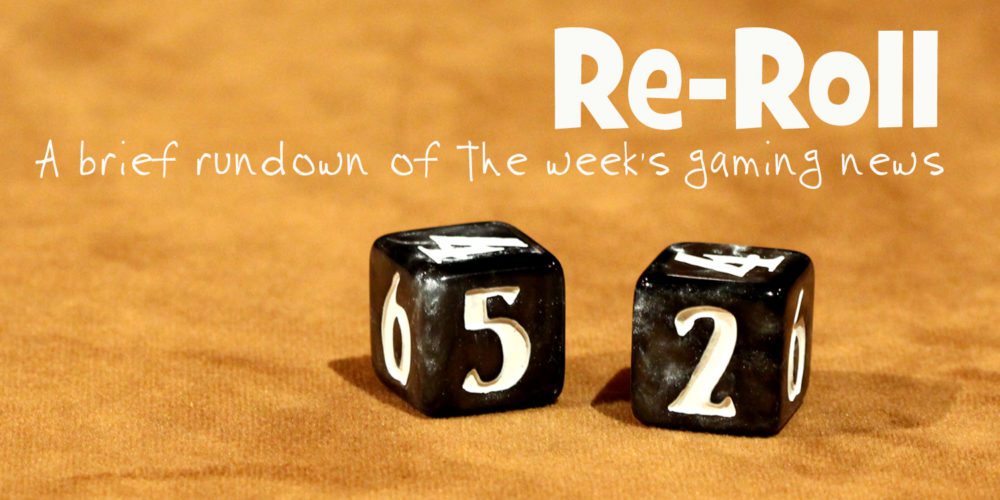


What a fantastic theme, and great gameplay. I look forward to backing this one.